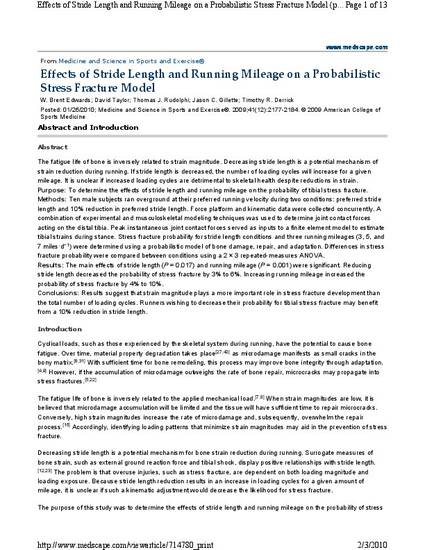
Article
Effects of Stride Length and Running Mileage on a Probabilistic Stress Fracture Model
Medicine & Science in Sports & Exercise
Document Type
Article
Disciplines
Publication Version
Accepted Manuscript
Publication Date
1-1-2009
DOI
10.1249/MSS.0b013e3181a984c4
Abstract
The fatigue life of bone is inversely related to strain magnitude. Decreasing stride length is a potential mechanism of strain reduction during running. If stride length is decreased, the number of loading cycles will increase for a given mileage. It is unclear if increased loading cycles are detrimental to skeletal health despite reductions in strain. Purpose: To determine the effects of stride length and running mileage on the probability of tibial stress fracture. Methods: Ten male subjects ran overground at their preferred running velocity during two conditions: preferred stride length and 10% reduction in preferred stride length. Force platform and kinematic data were collected concurrently. A combination of experimental and musculoskeletal modeling techniques was used to determine joint contact forces acting on the distal tibia. Peak instantaneous joint contact forces served as inputs to a finite element model to estimate tibial strains during stance. Stress fracture probability for stride length conditions and three running mileages (3, 5, and 7 miles·d−1) were determined using a probabilistic model of bone damage, repair, and adaptation. Differences in stress fracture probability were compared between conditions using a 2 × 3 repeated-measures ANOVA. Results: The main effects of stride length (P = 0.017) and running mileage (P = 0.001) were significant. Reducing stride length decreased the probability of stress fracture by 3% to 6%. Increasing running mileage increased the probability of stress fracture by 4% to 10%. Conclusions: Results suggest that strain magnitude plays a more important role in stress fracture development than the total number of loading cycles. Runners wishing to decrease their probability for tibial stress fracture may benefit from a 10% reduction in stride length.
Copyright Owner
American College of Sports Medicine
Copyright Date
2009
Language
en
File Format
application/pdf
Citation Information
W. Brent Edwards, David Taylor, Thomas J. Rudolphi, Jason C Gillette, et al.. "Effects of Stride Length and Running Mileage on a Probabilistic Stress Fracture Model" Medicine & Science in Sports & Exercise Vol. 41 Iss. 12 (2009) p. 2177 - 2184 Available at: http://works.bepress.com/thomas-rudolphi/9/

This is a non-final version of an article published in final form in Medicine & Science in Sports & Exercise 41 (2009): 2177, doi: 10.1249/MSS.0b013e3181a984c4. Posted with permission.